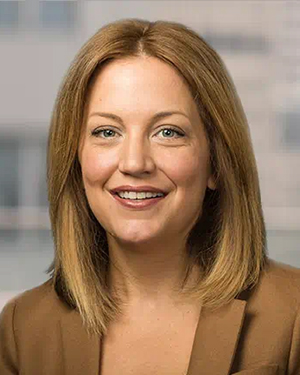With more than $150 billion in assets under management, Nuveen Real Estate has an informed viewpoint on the state of real estate investment opportunities in the U.S. and globally.
Earlier this year, Nuveen acquired a massive affordable housing portfolio in a deal that helped push Nuveen’s overall footprint in that sector to more than $6 billion.
That is representative of Nuveen’s current investment theses within the real estate sector, which includes a focus on residential investment opportunities alongside industrial.
Nuveen invests across all property types and in debt and equity. It also has open-end funds geared towards core real estate, as well as others that focus on opportunistic and value-add deals. In addition, Nuveen operates a non-traded REIT, providing access to retail investors.
WMRE spoke with Carly Tripp, Global Chief Investment Officer and Head of Investments for Nuveen Real Estate, to assess the investment manager’s current view on the market.
This interview has been edited for style, length and clarity.
WMRE: Let’s start with the big picture. What are your thoughts on the commercial real estate investment landscape?
 Carly Tripp: Our high conviction strategies remain housing, industrial and real estate alts like self-storage and healthcare-related real estate. The fundamentals have remained strong in all of those sectors. Taking industrial as an example, 49 of 50 of largest markets in the U.S. remain below their historical average in vacancy. So, with industrial we remain very positive.
Carly Tripp: Our high conviction strategies remain housing, industrial and real estate alts like self-storage and healthcare-related real estate. The fundamentals have remained strong in all of those sectors. Taking industrial as an example, 49 of 50 of largest markets in the U.S. remain below their historical average in vacancy. So, with industrial we remain very positive.
There was some softening in net absorption in recent quarters, but it’s not something that was unexpected. It’s moderating off of highs, but it remains incredibly strong. Looking at occupancies, rent growth and lease trade-outs, the signals are very positive. Couple that with lots of noise about potential incoming supply, which was halted or slowed because of financing constraints we face today, and that has softened the impact of new development in that segment.
With housing, structurally we see an undersupply across the U.S. that is a long-term phenomenon. We are seeing distinction across markets. Sun Belt markets were the darling of the housing/apartment sector over the past five years, but that’s also where developers have focused, so now there are some concerns about the Sun Belt. That is flowing through to operations, where coastal markets like New York in particular are seeing the strongest rent growth. It’s been undersupplied and ignored by developers recently. That is the one change to our housing thesis going forward.
WMRE: Can you talk about some of the alt real estate segments you mentioned?|
Carly Tripp: Self storage continues to outperform. Over the last 10 years, it has outperformed its peer set 80% of the time. We continue to see a strong market there. From a relative standpoint, it represents a small amount of disposal income and increasingly is viewed as a necessity rather than luxury.
With medical office and healthcare real estate, there is an aging population that is spending more per capita on healthcare. There are a lot of tailwinds there. The fundamentals are incredibly strong and there is resilience to volatility. They have been able to absorb pressure from the rate cycle.
There’s also some differences globally. Europe and the United Kingdom were faster to course correct. The U.K. is down about 18% to peak pricing vs. 8% in the U.S. So we are seeing some positive momentum in terms of pricing.
WMRE: Given the picture you laid out, how do you deal with some of the headlines about doom and gloom for commercial real estate. How to convey the nuance that the narratives are very different for office, which is facing real challenges, than for other segments that are not?
Carly Tripp: Real estate always gets wrapped up in the headlines whereas, say, trying to understand the value of a public equity is much more complicated. We’ve gone through this before. We had to spend time decoupling the subprime crisis from other real estate. The scar issue lived for a long time.
Today, the narrative is dominated by the office sector and particularly the U.S. office sector. In other places, there has been a stronger performance and higher demand from both the tenant and capital perspective. In the U.S. we had an accelerated discovery period. There was technical disruption with Zoom as the catalyst. We don’t need to use the amount of office space that we have used historically. It’s not dissimilar to what happened with large form retail and impact of e-commerce.
In the office sector, there will be reduced demand in the U.S. going forward. There will be haves and have nots. But if you [think] holistically and you ask if there is contagion, the answer is, “No.” The office sector is not poised to be a catalyst to take down the entire industry, which has proven pretty resilient.
WMRE: How are you structuring your real estate investment products currently?
Carly Tripp: It’s a global suite of products. Categorically, we put them in two buckets. There is the “resilient series,” which are core products and not dissimilar to ODCE funds. In the U.S. we have four core open-end funds focused on the four major commercial real estate sectors. In Europe, there are open-end diversified funds.
Then there is our “enhanced series,” which is more of your typical value-add/opportunistic investments. It’s a way of enhanced returns. In the U.S. we have those offered on a sector basis. U.S. investors expect a more niche offering vs. in Europe where it is a diversified, value-add offering.
WMRE: And can you talk about your investor base. You work a lot with institutions, but also do have some retail investors as well, correct?
Carly Tripp. The funds I mentioned before are predominantly for institutional investors. We do have some retail investors as well. We have the non-traded Nuveen Global Cities REIT. That’s all for retail investors.
WMRE: How important is the wealth channel going forward?
Carly Tripp: It’s something we look toward a lot. As an industry, if you think about where your capital sources have been, a lot has come from pension systems or sovereign wealth funds. Going forward, it will be a lot less dependent on pensions and a lot more on individuals investing their own dollars. Individuals being able to access private markets is attractive. I’ve seen a lot of divergence from the 60/40 portfolio.
In the Global Cities REIT, we invest in mortgages, as well as REITs. It offers a portfolio complementary to private real estate, but also offers some liquidity. We try and construct it around where our conviction is at any point in time.
Consumers are going to demand access to non-public market trades. There are a lot of offerings in the infrastructure space and in private equity. Closed-end value funds are a great place too. I think it will help strengthen portfolios by offering diversification in vintage, timing and in asset classes. Real estate is much less volatile and offers a higher return than bonds. There’s also a strong cash yield. It sits well within the middle of an equity/bond portfolio.
WMRE: And you look at both debt and equity opportunities within real estate?
Carly Tripp: Yes. And we are tilted to overweighting debt right now. Treasuries are above 4%. Real estate debt is getting a healthy spread on top of that. There’s a lot of pricing power for lenders. So, you can firm up your terms from that perspective. An often times you can go in at a higher yield than you can in the equity markets, albeit there’s not a whole lot transacting in equity markets. If there’s ever a point of time when we are living in uncertainty and you can live better as a lender than a borrower, we generally tilt our portfolios to lean towards debt.
WMRE: Any final thoughts?
Carly Tripp: For property types, retail has been on my radar for several years as a recommendation, talking more about necessity and retail-led mixed-use projects, not necessarily malls.
Within the last 12 months, it’s been the best performing sector. There is increased life and increased foot traffic. The consumer is relatively still strong. What we are seeing on the broad day-to-day is increased demand and activity and net/net absorption is positive. New store openings and total sales are also good stories.
While e-commerce is sticky and its proportion has grown, the overall pie has also grown. Bricks-and-mortar retail sales have grown. And there has been almost no net new retail supply. Instead, a lot of large format retail has been redeveloped into other uses. So, especially outdoor, lifestyle, retail-led mixed-use and necessity retail is going to perform very well. We would expect investors to dip their toe back in those waters.





